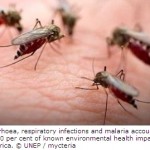 Nairobi, Kenya – Smallholder farmers across East Africa have started to embrace climate-resilient farming approaches and technologies, according to new research published by the CGIAR Research Program on Climate Change, Agriculture and Food Security (CCAFS). At the same time, the survey evidence suggests that many of the changes in farming practices are incremental, rather than transformative in nature, and that high levels of food insecurity prevent many from making all of the changes needed in order to cope with a changing climate.
Nairobi, Kenya – Smallholder farmers across East Africa have started to embrace climate-resilient farming approaches and technologies, according to new research published by the CGIAR Research Program on Climate Change, Agriculture and Food Security (CCAFS). At the same time, the survey evidence suggests that many of the changes in farming practices are incremental, rather than transformative in nature, and that high levels of food insecurity prevent many from making all of the changes needed in order to cope with a changing climate.
The study – released one year after East Africa’s worst drought in 60 years hit its peak – is based on a survey of over 700 farming households in four East African countries carried out by CCAFS, part of a larger effort covering 5,040 households in 252 villages across 36 sites in 12 countries in East Africa, West Africa and South Asia. It appeared online before publication in the journal Food Security.
“For generations, farmers and livestock keepers in East Africa have survived high levels of weather variability by testing and adopting new farming practices. As this variability increases, rainfall patterns shift, and average temperatures rise due to climate change, they may need to change faster and more extensively,” said Patti Kristjanson, a CCAFS Theme Leader who co-led the comprehensive study and works at the Nairobi-based World Agroforestry Centre (ICRAF).
“We are seeing that agricultural diversification strategies are key to improved household well-being,” Kristjanson added. “Improved access to good crop, livestock, soil, land and water management information and options for different environments is needed now more than ever.”
The survey found that farmers have embraced a wide range of strategies to improve crop production:
- 55 percent of households have taken up at least one shorter-cycle crop variety, and 56 percent adopted at least one drought tolerant variety. These practices help farmers work around periods of heat and water scarcity.
- 50 percent of households are planting trees on their farms, a practice known as agroforestry. These trees help stabilize eroding landscapes, increase water and soil quality, and provide yields of fruit, tea, coffee, oil, fodder, medicinal and energy products.
- 50 percent introduced inter-cropping – alternating different plants in the same plot – and 25 percent started rotating their crops during the last decade. These and other techniques help maintain and improve soil fertility and enhance crop yields.
Other proven agricultural productivity improvement strategies have yet to take root widely, however, as the findings show that:
- Only 25 percent of households have begun using manure or compost and 23 percent are now mulching. These techniques help improve soil and alleviate the need for more costly practices, such as applying petroleum-based fertilizer.
- 16 percent of the surveyed households have introduced improved soil management techniques such as terracing, building ridges or other techniques that reduce water and soil organic matter losses.
- 10 percent have begun trying to store or manage agricultural water. As demands on fresh water resources multiply, farmers need to embrace ways in which they effectively use what they have, for example through rainwater harvesting.
In livestock management, farmers have implemented a number of methods to improve productivity and reduce emissions:
- 34 percent have reduced livestock herd sizes and 48 percent are managing their resources better, for example, by growing crops for animal feed. These changes can help farmers adjust to changing weather patterns; and better diets can also lower methane emissions per kg of meat and milk produced.
- One-third of agropastoral households in Ethiopia, and one-fifth in Tanzania are managing pasture lands better – actions such as planting better forage varieties and fencing off grazing areas. According to researchers, these changes will be key to feeding livestock in a changing climate, as well as, lowering greenhouse gas emissions, but few in Kenya and Uganda have adopted such practices.
Click here to view the findings as an infographic.
 Food Insecurity Remains a Barrier to Climate Adaptation
Food Insecurity Remains a Barrier to Climate Adaptation
According to the study, a key factor that limited adaption is food insecurity. Farm families at all five study sites had to confront this issue; they faced food deficits on average for two months in Nyando, Kenya, and for more than half the year in Borana, Ethiopia.
“Which comes first, the chicken or the egg? It stands to reason that households struggling to feed their families throughout the year are not in a good position to invest in new practices that include higher costs and risks,” said Kristjanson. “Yet not adapting is certainly contributing to food insecurity. Food insecurity means lower adaptive capacity to deal with all kinds of change.”
“So it is critical that we learn more about both the factors that enable and facilitate innovation, and how to lower the often hidden costs and barriers associated with changing agricultural practices,” she added.














